With eco-friendly green management policy to reduce greenhouse gas emissions and environmental pollution, we respond to global climate change for the development of sustainable society.
Social Good Partner

-
Green Management Policy
Based on the vision of ‘Social Companion – Social Good Partner’, Hyundai Corporation strives to become a sustainable corporation. Recently, international efforts to have interest in climate change and environmental issues and solve these issues are continuing. In light with such international trend, Hyundai Corporation is conducting green mobility business such as EV parts, renewable energy business, green material business and building green energy infrastructure such as hydrogen and related business in order to deal with global climate change and maintain green management system.
-
Environmental Goals, Implementation Plans, and Progress
Hyundai Corporation has set its mid- to long-term environmental goals in line with its environmental management policy, and continues to strive to achieve them by establishing step-by-step goals. The company has two main goals: ‘implementation of RE100’ and ‘expansion of eco-friendly energy and mobility-related businesses’. RE100 is being promoted by Hyundai Renewable Lab, which is in the solar power business. Renewable energy-related businesses include solar energy investment and electric vehicle-related business development. Our Passenger Car Parts Division is taking an interest in the eco-friendly electric vehicle-related business, which has recently become a global buzz, and is making continuous efforts to discover and expand new businesses.
Environmental Goals (Mid- to Long-Term) Implementation Plan (Short-Term) Key Progress Implementation of RE 100 Implementation of RE 60 The company is implementing RE 60 with Unit 3 of Hyundai Renewable Lab. The company considers concluding a contract among KEPCO, Hyundai Corporation, and Yonhap News building with a view to supplying 60% of the company’s power consumption from the solar power of Hyundai Renewable Lab. Expand business related to eco-friendly energy and mobility Increase investment in solar power plants (KRW 3.135 billion and generation capacity of 2,578kW eyed in 2021) From 2017: Since the creation of Hyundai Renewable Lab, the company has continuously increased solar power generation.
From 2020: The company has completed its investment, and Unit 2 in Japan (Mimasaka) has gone into operation.
From 2021: The company has completed its investment, and Unit 3 in Japan (Yumesaki) has gone into operation.Promotion of composite material business for electric vehicles The company is working to export composite materials for electric vehicles through cooperation with South Korean automotive materials companies. -
Green Management TFT Activity
In order to promote green management, Hyundai Corporation has form a practical TF organization that combines both the management sector and the sales sector to take mid- to long-term response to global climate change, and is conducting activities to minimize environmental effects from the head office and overseas business sites. Major tasks under the green management TFT include RE100: implementing 100% supply of renewable energy of required electricity, continuing investment and inspecting on operation of eco-friendly photovoltaic power plant, introducing paperless way of work by introducing digital work system, recycling paper for printing and photocopying, switching off the lights and computers during breaks, minimizing the use of elevators by campaigning about healthy walking and the use of stairs, and setting up plans to educate staff on green management.
-
Energy Saving Activities
Hyundai Corporation strives for sustainable development of the human race by reducing the energy use. Yonhap News Building, where the company is stationed, has installed environmentally friendly photovoltaic panels in the windows to supply for part of the electricity consumption in the building, and actuated signal taps are used in all toilets to save energy and water as part of the building’s eco-friendly operation.
• Energy Saving Activity : Hyundai Corporation continuously reduces energy consumption by campaigning about switching the lights off outside the hours (evenings and lunch time) and saving on water. As for the electricity, we achieved reduction from 175,448khw in 2018 to 154,394khw in 2019 and 140,177khw in 2020 for 3 consecutive years. As for the water, we achieved continuous reduction from 264 ton in 2018 to 232 ton in 2019, and 213 ton in 2020.
• Waste Disposal Reduction Activity : Hyundai Corporation’s domestic business sites produce no wastes other than the life wastes from Yonhap News Building where it is currently stationed. In order to minimize the disposal of life wastes, we are continuing activities such as paperless meetings company-wide by introducing digital meeting equipment (reduction of approximately 70% in consumables such as printer toner), minimizing computer related wastes through the use of VDI (virtual desktop) among all staff, and minimizing the use of printing paper by advising double-sided printing.
-
Renewable Energy Investment Activities
Since founding a renewable energy investment corporation Hyundai Renewable Lab in 2017, Hyundai Corporation has been making continuous investments to development of sustainable business models and renewable energy (photovoltaic) in and out of Korea. In terms of annual investment execution status, we have invested KRW 1.38 billion in 2017, KRW 2 billion in 2018, KRW 8.36 billion in 2019, and KRW1 .08 billion in 2020, and we’re planning on investing KRW 3.14 billion in 2021.
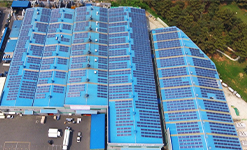 • No. 1 in Korea, 686 kW, roof-type (Wanju, Jeonbuk)
• No. 1 in Korea, 686 kW, roof-type (Wanju, Jeonbuk)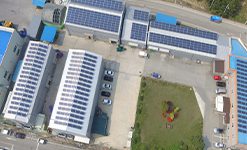 • No. 2 in Korea, 185 kW, roof-type (Nonsan, Chungnam)
• No. 2 in Korea, 185 kW, roof-type (Nonsan, Chungnam)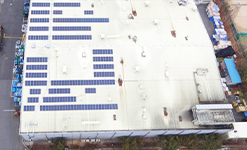 • No. 3 in Korea, 96 kW, roof-type (Wanju, Jeonbuk)
• No. 3 in Korea, 96 kW, roof-type (Wanju, Jeonbuk)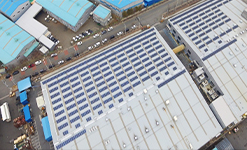 • No. 4 in Korea, 398 kW, roof-type (Wanju, Jeonbuk)
• No. 4 in Korea, 398 kW, roof-type (Wanju, Jeonbuk)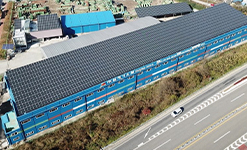 • No. 5 in Korea, 674 kW, roof-type (Wanju, Jeonbuk)
• No. 5 in Korea, 674 kW, roof-type (Wanju, Jeonbuk)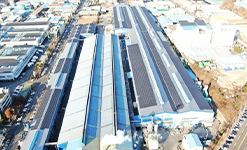 • No. 6 in Korea, 2,897 kW, roof-type (Gyeongsan, Gyeongbuk)
• No. 6 in Korea, 2,897 kW, roof-type (Gyeongsan, Gyeongbuk)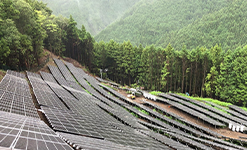 • No. 1 in Japan, 1,166 kW, field (Kuromata)
• No. 1 in Japan, 1,166 kW, field (Kuromata)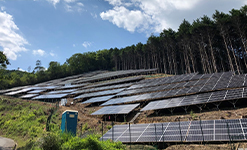 • No. 2 in Japan, 578 kW, field (Mimasaka)
• No. 2 in Japan, 578 kW, field (Mimasaka)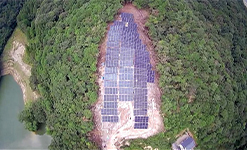 • No. 3 in Japan, 500 kW, field (Yumesaki)
• No. 3 in Japan, 500 kW, field (Yumesaki)

